Análisis de los factores determinantes del resultado exportador en las empresas españolas del sector calzado
DOI:
https://doi.org/10.12795/rea.2021.i42.07Palabras clave:
Internacionalización, Marketing internacional, Resultado exportador, Exportación, Gestión empresarial, Sector calzadoResumen
Esta investigación pretende profundizar en el comportamiento de las empresas exportadoras del sector calzado, uno de los más importantes en el levante español, que genera valor añadido a través de la moda. El testimonio de los directivos de una muestra de empresas representativas, mostrará las fortalezas y debilidades de sus procesos de internacionalización, prestando especial importancia a variables como la estrategia de marketing internacional o la propia función directiva. Por otra parte, el análisis descriptivo de los principales condicionantes del resultado exportador, mostrará que los directivos del sector están bien formados, que el entorno y las características de la empresa van a condicionar la estrategia de marketing y que ésta incorpora elementos relacionales y ciertos aspectos de las nuevas tecnologías. Todo ello repercute en la evolución hacia un entorno basado en los servicios y en el estudio del mercado con el fin de identificar de la mejor forma posible las necesidades del cliente. Finalmente, desde el punto de vista académico, se analizará la contribución de teorías como el enfoque de los recursos, las capacidades dinámicas o la teoría de la contingencia.
Descargas
Citas
Aaby, N. E. & Slater, S. F. (1989). Management influences on export performance: a review of the empirical literature 1978-88. International marketing review, 6(4), 7-26.https://doi.org/10.1108/EUM0000000001516
Alvarez, R. (2004). Sources of export success in small-and medium-sized enterprises: the impact of public programs. International Business Review, 13(3), 383-400.https://doi.org/10.1016/j.ibusrev.2004.01.002
Baldauf, A., Cravens, D. W.& Wagner, U. (2000). Examining determinants of export performance in small open economies. Journal of World Business, 35(1), 61-79.https://doi.org/10.1016/S1090-9516(99)00034-6
Barney, J. (1991). Firm resources and sustained competitive advantage. Journal of management, 17(1), 99-120. https://doi.org/10.1177/014920639101700108
Bilkey, W. J. (1978). An attempted integration of the literature on the export behavior of firms. Journal of international Business studies, 9(1), 33-46. https://doi.org/10.1057/palgrave.jibs.8490649
Bouncken, R. B., Schuessler, F. & Kraus, S. (2015). The theoretical embedding of born globals: Challenging existing internationalization theories. International Business & Economics Research Journal (IBER), 14(1), 39-46. https://doi.org/10.19030/iber.v14i1.9030
Cavusgil, S. T. & Zou, S. (1994). Marketing strategy-performance relationship: an investigation of the empirical link in export market ventures. Journal of marketing, 58(1), 1-21. https://doi.org/10.1177/002224299405800101
CESCE, Compañía Española de Seguros de Crédito a la Exportación (2018). Informe sectorial de la economía española. https://issuu.com/cesce.es/docs/informe_sectorial_2018
CESCE, Compañía Española de Seguros de Crédito a la Exportación (2019). Informe sectorial de la economía española. https://issuu.com/cesce.es/docs/informe_sectorial_cesce_2019
Chabowski, B., Kekec, P., Morgan, N. A., Hult, G. T. M., Walkowiak, T. & Runnalls, B. (2018). An assessment of the exporting literature: Using theory and data to identify future research directions. Journal of International Marketing, 26(1), 118-143. https://doi.org/10.1509/jim.16.0129
Chen, J., Sousa, C. M. & He, X. (2016). The determinants of export performance: a review of the literature 2006-2014. International Marketing Review. https://doi.org/10.1108/IMR-10-2015-0212
Chugan, P. K. & Singh, S. (2014). Taxonomy for firm-level determinants of export performance. Universal Journal of Industrial and Business Management, 2(1), 6-12. https://doi.org/10.13189/ujibm.2014.020102
Contractor, F. J., Hsu, C. C. & Kundu, S. K. (2005). Explaining export performance: a comparative study of international new ventures in Indian and Taiwanese software industry. MIR: Management International Review, 83-110.
DeSarbo, W. S., Anthony Di Benedetto, C., Song, M. & Sinha, I. (2005). Revisiting the Miles and Snow strategic framework: uncovering interrelationships between strategic types, capabilities, environmental uncertainty, and firm performance. Strategic management journal, 26(1), 47-74. https://doi.org/10.1002/smj.431
Fernández-Mesa, A. & Alegre, J. (2015). Entrepreneurial orientation and export intensity: Examining the interplay of organizational learning and innovation. International Business Review, 24(1), 148-156. https://doi.org/10.1016/j.ibusrev.2014.07.004
Francis, J. & Collins-Dodd, C. (2004). Impact of export promotion programs on firm competencies, strategies and performance. International Marketing Review. https://doi.org/10.1108/02651330410547153
Grant, R. M. (1996). Prospering in dynamically-competitive environments: Organizational capability as knowledge integration. Organization science, 7(4), 375-387. https://doi.org/10.1287/orsc.7.4.375
Green, K. M., Covin, J. G. & Slevin, D. P. (2008). Exploring the relationship between strategic reactiveness and entrepreneurial orientation: The role of structure-style fit. Journal of Business Venturing, 23(3), 356-383. https://doi.org/10.1016/j.jbusvent.2007.01.002
Gummesson, E. (2002). Relationship marketing and a new economy: it’s time for de-programming. Journal of services marketing. https://doi.org/10.1108/08876040210447315
ICEX - Instituto Español de Comercio Exterior (2021). Base de datos ESTACOM. https://www.icex.es/icex/es/navegacion-principal/todos-nuestros-servicios/informacion-de-mercados/estadisticas/sus-estadisticas-a-medida/estadisticas-espanolas-estacom/index.html
IVACE – Instituto Valenciano de Competitividad Empresarial (2019). Análisis del sector calzado. https://www.ivace.es/Internacional_Informes-Publicaciones/Sectores-enlaces/CALZADO.pdf
Katsikeas, C. S., Leonidou, L. C. & Morgan, N. A. (2000). Firm-level export performance assessment: review, evaluation, and development. Journal of the Academy of Marketing Science, 28(4), 493-511. https://doi.org/10.1177/0092070300284003
Katsikeas, C. S., Samiee, S. & Theodosiou, M. (2006). Strategy fit and performance consequences of international marketing standardization. Strategic management journal, 27(9), 867-890. https://doi.org/10.1002/smj.549
Kotler, P. (2010). Marketing 3.0: from products to customers to the human spirit (No. 658.8 K8487m Ej. 1). JOHN WILLEY & SONS. https://doi.org/10.1002/9781118257883
Kotler, P., Kartajaya, H. & Setiawan, I. (2016). Marketing 4.0: Moving from traditional to digital. John Wiley & Sons.
Kotler, P., Kartajaya, H. & Setiawan, I. (2021). Marketing 5.0: Technology for Humanity. John Wiley & Sons.
Lages, L. F. & Montgomery, D. B. (2005). The relationship between export assistance and performance improvement in Portuguese export ventures. European Journal of marketing.
Leonidou, L. C., Katsikeas, C. S. & Samiee, S. (2002). Marketing strategy determinants of export performance: a meta-analysis. Journal of Business research, 55(1), 51-67. https://doi.org/10.1016/S0148-2963(00)00133-8
LiPuma, J. A., Newbert, S. L. & Doh, J. P. (2013). The effect of institutional quality on firm export performance in emerging economies: a contingency model of firm age and size. Small Business Economics, 40(4), 817-841. https://doi.org/10.1007/s11187-011-9395-7
Morgan, R. M. & Hunt, S. D. (1994). The commitment-trust theory of relationship marketing. Journal of marketing, 58(3), 20-38. https://doi.org/10.2307/1252308
Morgan, N. A., Katsikeas, C. S. & Vorhies, D. W. (2012). Export marketing strategy implementation, export marketing capabilities, and export venture performance. Journal of the academy of marketing science, 40(2), 271-289. https://doi.org/10.1007/s11747-011-0275-0
Murray, J. Y., Gao, G. Y. & Kotabe, M. (2011). Market orientation and performance of export ventures: the process through marketing capabilities and competitive advantages. Journal of the Academy of Marketing Science, 39(2), 252-269.
https://doi.org/10.1007/s11747-010-0195-4
Nelson, R. R. (1991). Why do firms differ, and how does it matter? Strategic management journal, 12(S2), 61-74. https://doi.org/10.1002/smj.4250121006
O’Cass, A. & Julian, C. (2003). Examining firm and environmental influences on export marketing mix strategy and export performance of Australian exporters. European journal of marketing. https://doi.org/10.1108/03090560310459005
Orlitzky, M., Siegel, D. S. & Waldman, D. A. (2011). Strategic corporate social responsibility and environmental sustainability. Business & society, 50(1), 6-27. https://doi.org/10.1177/0007650310394323
Parnell, J. A., Long, Z., & Lester, D. (2015). Competitive strategy, capabilities and uncertainty in small and medium sized enterprises (SMEs) in China and the United States. Management Decision. https://doi.org/10.1108/MD-04-2014-0222
Payne, A. & Frow, P. (2005). A strategic framework for customer relationship management. Journal of marketing, 69(4), 167-176. https://doi.org/10.1509/jmkg.2005.69.4.167
Payne, A. F., Storbacka, K. & Frow, P. (2008). Managing the co-creation of value. Journal of the academy of marketing science, 36(1), 83-96. https://doi.org/10.1007/s11747-007-0070-0
Payne, A. & Frow, P. (2017). Relationship marketing: looking backwards towards the future. Journal of services marketing. https://doi.org/10.1108/JSM-11-2016-0380
Prahalad, C. K. & Hamel, G. (1990). Core competency concept. Harvard Business Review, 64(3), 70-92.
Prasad, V. K., Ramamurthy, K. & Naidu, G. M. (2001). The influence of Internet-marketing integration on marketing competencies and export performance. Journal of International Marketing, 9(4), 82-110. https://doi.org/10.1509/jimk.9.4.82.19944
Ruzzier, M., Hisrich, R. D. & Antoncic, B. (2006). SME internationalization research: past, present, and future. Journal of Small Business and Enterprise Development, 13(4), 476-497. https://doi.org/10.1108/14626000610705705
Song, M., Nason, R. W. & Di Benedetto, C. A. (2008). Distinctive marketing and information technology capabilities and strategic types: A cross-national investigation. Journal of International Marketing, 16(1), 4-38. https://doi.org/10.1509/jimk.16.1.4
Sousa, C. M. (2004). Export performance measurement: an evaluation of the empirical research in the literature. Academy of marketing science review, 2004, 1.
Sousa, C. M., Martínez-López, F. J. & Coelho, F. (2008). The determinants of export performance: A review of the research in the literature between 1998 and 2005. International Journal of Management Reviews, 10(4), 343-374. https://doi.org/10.1111/j.1468-2370.2008.00232.x
Sousa, C. M. & Lengler, J. (2009). Psychic distance, marketing strategy and performance in export ventures of Brazilian firms. Journal of Marketing Management, 25(5-6), 591-610. https://doi.org/10.1362/026725709X461876
Stöttinger, B. & Holzmüller, H. H. (2001). Cross-national stability of an export performance model-a comparative study of Austria and the US. MIR: Management International Review, 7-28.
Teece, D. J., Pisano, G. & Shuen, A. (1997). Dynamic capabilities and strategic management. Strategic management journal, 18(7), 509-533. https://doi.org/10.1002/(SICI)1097-0266(199708)18:7<509::AID-SMJ882>3.0.CO;2-Z
Vargo, S. L. & Lusch, R. F. (2004). Evolving to a new dominant logic for marketing. Journal of marketing, 68(1), 1-17. https://doi.org/10.1509/jmkg.68.1.1.24036
Vargo, S. L. & Lusch, R. F. (2016). Institutions and axioms: an extension and update of service-dominant logic. Journal of the Academy of marketing Science, 44(1), 5-23. https://doi.org/10.1007/s11747-015-0456-3
Wernerfelt, B. (1984). A resource-based view of the firm. Strategic management journal, 5(2), 171-180. https://doi.org/10.1002/smj.4250050207
Wernerfelt, B. (1995). The resource-based view of the firm: Ten years after. Strategic management journal, 16(3), 171-174. https://doi.org/10.1002/smj.4250160303
White, D. S., Griffith, D. A. & Ryans, J. K. (1998). Measuring export performance in service industries. International Marketing Review.
Zhu, Z., Zhao, J. & Jin, X. (2013). A typology of net-enabled organisational capabilities for digital competitive advantage: the case study of travel and hospitality industry in China. International Journal of Networking and Virtual Organisations 11, 12(1), 56-69.
https://doi.org/10.1504/IJNVO.2013.051751
Zou, S. & Stan, S. (1998). The determinants of export performance: a review of the empirical literature between 1987 and 1997. International marketing review. https://doi.org/10.1108/02651339810236290
Publicado
Cómo citar
Número
Sección
Licencia
Derechos de autor 2021 Revista de Estudios Andaluces

Esta obra está bajo una licencia internacional Creative Commons Atribución-NoComercial-SinDerivadas 4.0.
La edición electrónica de la Revista de Estudios Andaluces se ofrece en acceso abierto desde el número 28 publicado en 2011 hasta la actualidad. Las ediciones impresa y electrónica de esta Revista son editadas por la Editorial de la Universidad de Sevilla, siendo necesario citar la procedencia en cualquier reproducción parcial o total.
La Revista de Estudios Andaluces no cobra tasas por el envío de trabajos, ni tampoco cuotas por la publicación de sus artículos. La Revista es gratuita desde el momento de la publicación de cada número y sus contenidos se distribuyen con la licencia “CreativeCommons Atribución-NoComercial-SinDerivar 4.0 Internacional” , que permite al usuario de la Revista de Estudios Andaluces criterios que cumplen con la definición de open access de la Declaración de Budapest en favor del acceso abierto. Puede consultar desde aquí la versión informativa y el texto legal de la licencia. Esta circunstancia ha de hacerse constar expresamente de esta forma cuando sea necesario.







